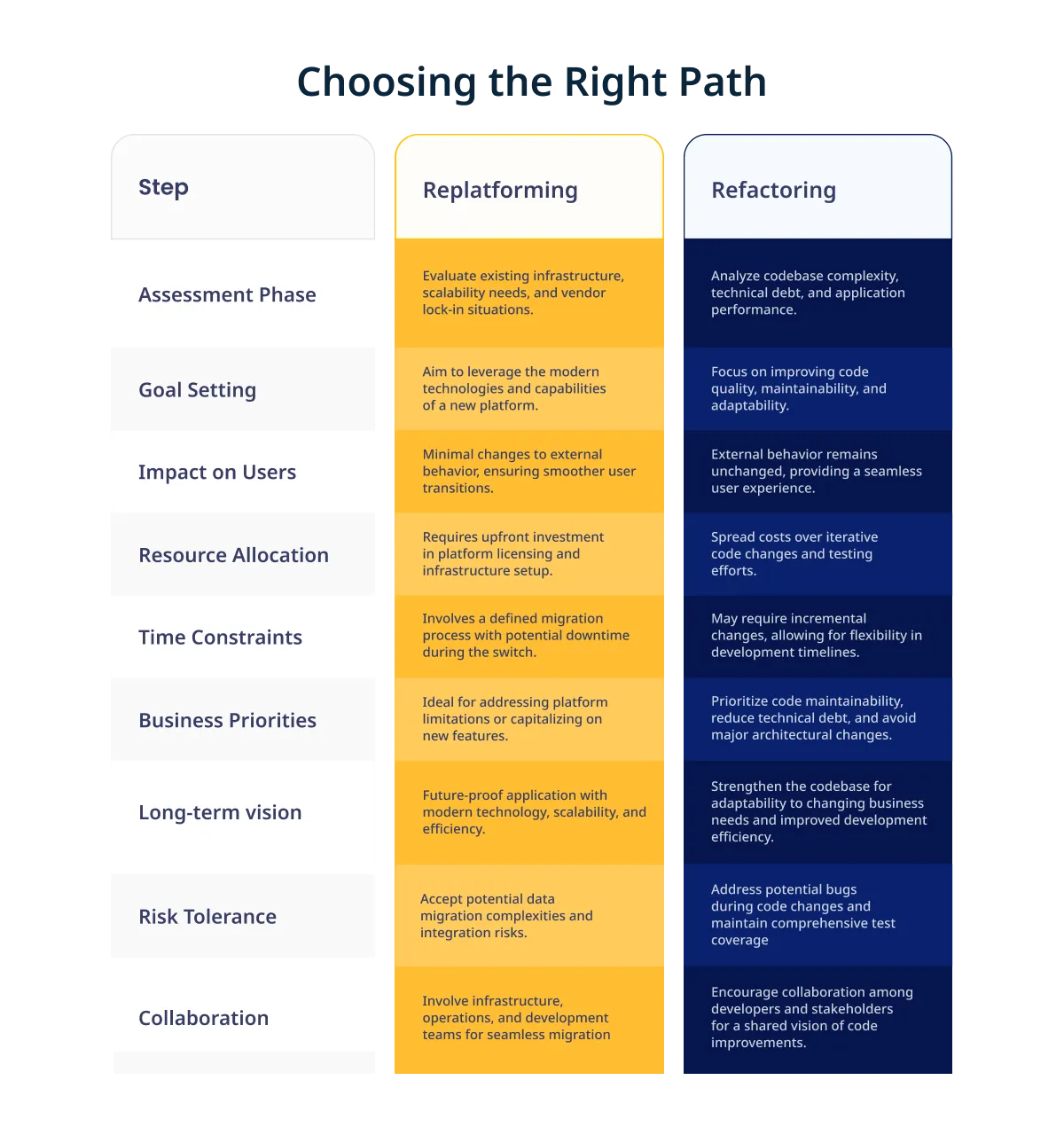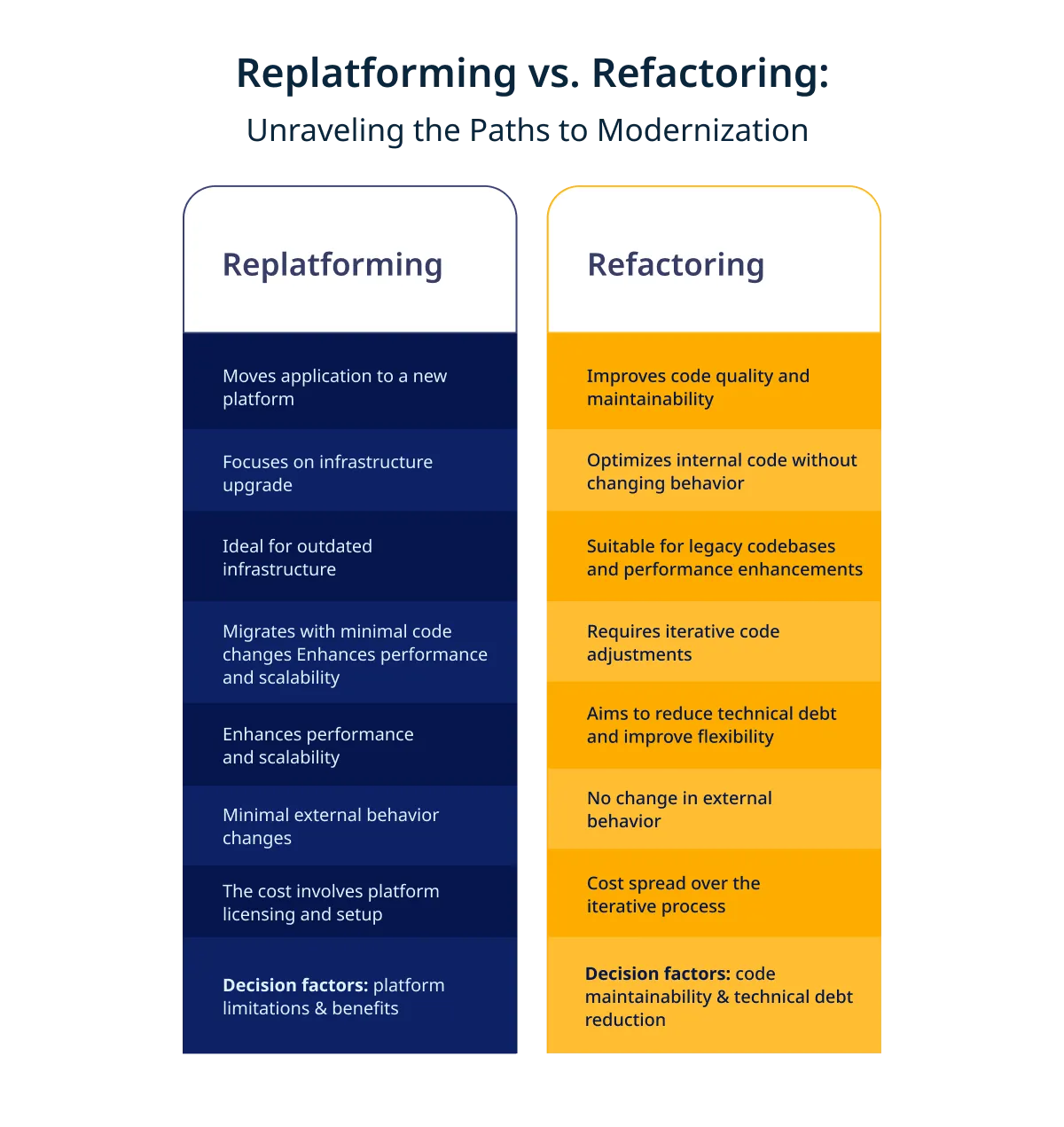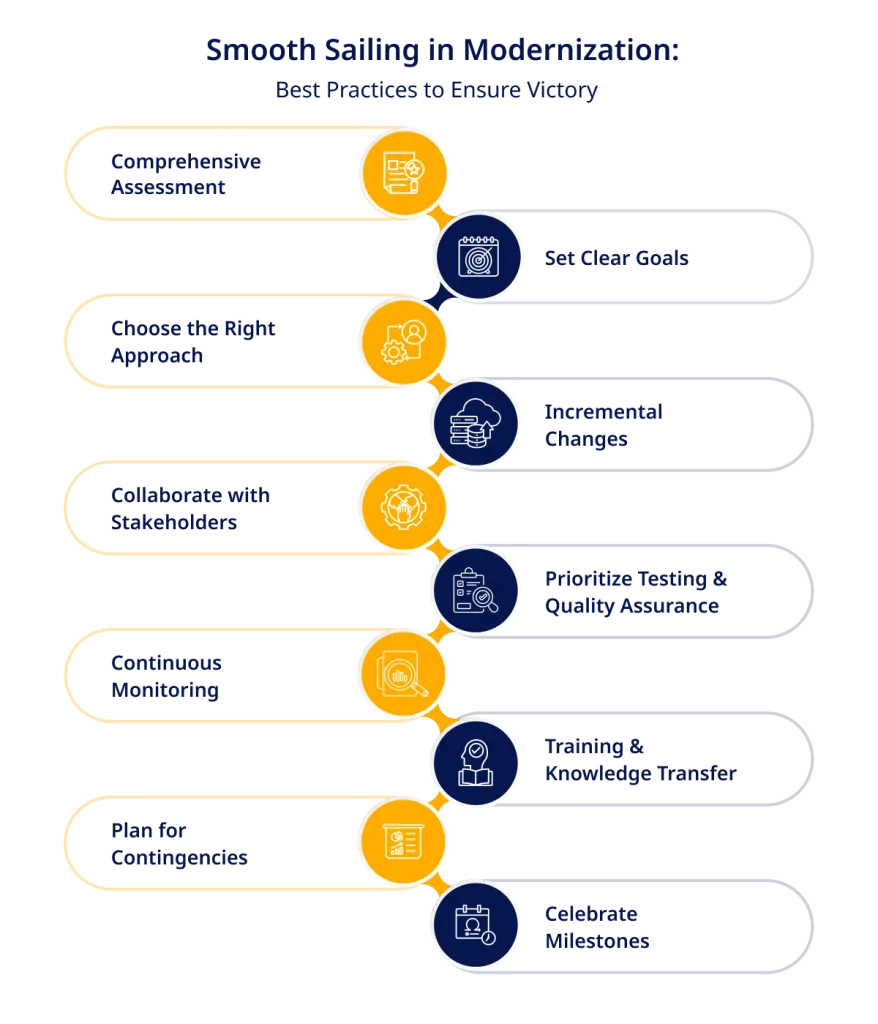As industries strive to stay competitive in an ever-evolving digital landscape, the choice between replatforming and refactoring emerges as a pivotal decision for businesses seeking to modernize their applications.
According to recent surveys, nearly 65% of enterprises actively consider modernization strategies to enhance their software performance and maintain a competitive edge.
Organizations must optimize their apps to meet rising customer expectations and business demands as technology develops rapidly.
But there is more than one-size-fits-all strategy for modernization. It necessitates thoroughly comprehending the subtle differences between replatforming and refactoring, each with unique advantages and difficulties.
This enlightening blog post explores modernization options, demystifying the nuances of replatforming and refactoring.
We’ll help you through the decision-making process and arm you with the knowledge you need to choose that aligns with your specific business objectives so you won’t have to worry about it anymore.
Understanding Replatforming
Replatforming is a Modernization strategy that entails moving an old system or application to a new platform while keeping its essential features.
It aims to improve the program’s performance, scalability, and maintainability by utilizing the advantages of a more sophisticated and suitable platform.
Usually, companies offering cloud application development services help businesses with replatforming.
So, while approaching them for your project, ensure they can leverage this strategy’s following benefits.
Key Characteristics and Benefits of Replatforming
- Platform Upgrade: Businesses can upgrade their underlying platform by replatforming, such as switching from on-premises infrastructure to a cloud-based solution. Numerous benefits, such as enhanced resource allocation, increased flexibility, and cost savings, come with this change.
- Performance Boost: By migrating to a new platform, businesses can use modern infrastructure and technologies, enhancing system performance. This results in faster response times, better user experiences, and improved efficiency.
- Scalability and Elasticity: Businesses can frequently use the scalability and flexibility advantages of modern platforms by replatforming. This means the program won’t suffer from performance deterioration when dealing with growing workloads, accommodating user growth, and adapting to changing needs.
- Access to New Features: Businesses can employ cutting-edge infrastructure and technology by switching to a new platform, which improves system performance. As a result, reaction times are quicker, users have a better experience, and efficiency is increased.
Leverage our proven techniques to refactor legacy code or replatforming applications.
Challenges of Replatforming
To better understand Replatforming vs. Refactoring in Modernization, let’s get familiar with some of the common challenges associated with replatforming:
1. Data Migration Complexity: Data migration from one platform to another can be challenging, especially when working with massive amounts of data or disparate data formats. It is crucial to guarantee data integrity and a smooth migration procedure to prevent interruptions. With the help of application migration & modernization services, you can migrate the data while dodging the complexities.
2. Integration Issues: Replatforming might call for integrating the program with other current systems, which could present compatibility issues and require substantial development work. Integrations must be carefully planned & tested to ensure smooth operation. Our case study on Data Migration To a More Efficient Platform can help you understand how you can overcome the integration challenges.
3. Downtime and Business Disruption: Replatforming often involves a period of downtime or reduced functionality during the migration process. This can impact business operations, customer experience, and revenue generation. Mitigating downtime through careful planning and execution is vital.
4. Skill and Knowledge Gaps: Adopting a new platform may require upskilling or acquiring new expertise within the IT team. Lack of familiarity with the new platform can lead to implementation difficulties and potential delays.
5. Cost Considerations: Replatforming can entail upfront costs for licensing, infrastructure setup, and training, as well as ongoing expenses for maintenance and support. Accurately assessing the financial implications ensures the investment aligns with the expected benefits.
Common Scenarios Replatforming Approach is Preferred
On comparing both approaches, Replat forming Vs. Refactoring in Modernization, you’ll find each one has its significance. So let’s find out some common scenarios where replatforming is preferred.
Scenario #1. Outdated Infrastructure
Applications running on outdated or unsupported infrastructure face performance limitations and security vulnerabilities. Replatforming allows businesses to upgrade to a modern and robust platform, improving overall application performance and security.
Scenario #2. Scalability Demands
As businesses grow, their applications must handle increasing workloads and user demands. Replatforming to a scalable cloud-based infrastructure enables applications to accommodate growth seamlessly. Businesses can consider having cross-platform app development services to meet their scalability goals and achieve desired results.
Scenario #3. Vendor Lock-In Concerns
Dependence on a specific vendor’s technology stack can restrict flexibility and scalability. Replatforming to a more vendor-neutral platform reduces the risk of vendor lock-in, providing more freedom to explore other solutions.
Scenario #4. Access to Advanced Features
New platforms often have cutting-edge features like artificial intelligence integration, advanced analytics, and automation capabilities. Replatforming enables businesses to leverage these features to gain a competitive edge.
Scenario #5. Regulatory Compliance Requirements
Changing regulatory standards may demand specific security or data handling protocols. Replatforming allows businesses to adopt platforms that align with the latest compliance requirements.
Also Read: Digital Transformation: Top Strategies For Modernizing Your Business
Exploring Refactoring
Refactoring is a strategic and iterative approach to modernization that involves making significant code-level changes to an existing application without changing its external behavior.
The primary goal of refactoring is to increase the application’s internal structure, improve code quality, and make it more maintainable, scalable, and efficient.
Key Characteristics and Benefits of Refactoring
If the comparison of Replatforming vs. Refactoring in Modernization confuses you, evaluate each one’s benefits and determine which suits your business better. Here are some of the key characteristics and benefits of refactoring:
1. Code Optimization: Refactoring enables developers to identify and eliminate code smells, redundant code, and performance bottlenecks. This optimization results in cleaner, more concise, and faster-running code.
2. Maintainability: Refactoring enhances its readability and maintainability by restructuring the codebase. It makes it easier for developers to understand, modify, and extend the application in the future, reducing the likelihood of introducing bugs during updates.
3. Scalability and Flexibility: Refactoring can introduce design patterns and architectural improvements that enhance the application’s scalability and flexibility. This ensures the system can accommodate future growth and adapt to changing business requirements.
4. Reduced Technical Debt: Refactoring reduces technical debt as code is improved and technical inefficiencies are addressed. This decreases the risk of encountering time-consuming and costly issues in the future.
Challenges of Refactoring
Though beneficial, refactoring comes with some challenges; below are some of them:
- The first challenge with refactoring is that it can be time-consuming, requiring careful planning and execution.
- While refactoring aims to maintain external behavior, there is a risk of introducing new bugs or unintended consequences during the code restructuring.
- Team members may fear refactoring could disrupt the application’s functionality, leading to a reluctance to make changes.
- Devoting resources to refactoring might divert efforts away from other critical tasks.
Discover how our tailored services can help you seamlessly migrate & optimize your app.
Common Scenarios Where Refactoring Approach is Preferred
When comparing Replatforming vs. Refactoring in modernization, evaluate their common scenarios and where these approaches best work. With refactoring, here are some of them:
Scenario #1. Legacy Codebases
Refactoring is highly valuable for legacy applications with convoluted, poorly documented code. By restructuring the codebase and eliminating technical debt, developers can breathe new life into the application and make it more sustainable.
Scenario #2. Performance Enhancements
Applications experiencing performance bottlenecks or slow response times can benefit from refactoring. Identifying and optimizing critical code sections can significantly improve the application’s performance and user experience.
Scenario #3. Maintainability and Extensibility
As applications evolve, maintaining and extending them can become increasingly challenging. Refactoring introduces design patterns and cleaner code, enhancing maintainability and facilitating future feature additions.
Scenario #4. Bug Fixes and Stability
Addressing recurring bugs and instability often requires a deeper analysis of the codebase. Refactoring enables developers to identify root causes and implement lasting solutions, ensuring a more stable and reliable application.
Scenario #5. Code Readability and Collaboration
Codebases with inconsistent naming conventions and poor readability hinder effective collaboration among development teams. Refactoring improves code clarity, making collaborating seamlessly easier for multiple developers.
Also Read: Staying Ahead In Enterprise Software: Latest Trends And Technologies
Comparing Replatforming and Refactoring
While replatforming and refactoring serve modernization purposes, they differ significantly in their focus & approach.
Replatforming concentrates on platform upgrades and infrastructure changes, while refactoring centers around optimizing and improving the existing codebase.
Each strategy has its strengths and challenges, making the decision between them dependent on the specific needs and goals of the application Modernization project.
Here is a tabular comparison of Replatforming vs. Refactoring in Modernization to help you differentiate between them better.
Best Practices for Successful Modernization
Modernizing an application is a complex process that requires specific expertise and skills. It is recommended to have a custom application development services company that can ensure successful implementation of the Modernization. For those with an in-house team, the following are the best practices for a successful modernization process to reap the full benefits of their efforts:
1. Comprehensive Assessment: You must thoroughly assess the existing application, architecture, and technology stack. Identify pain points, performance bottlenecks, and areas that require improvement. This assessment lays the groundwork for a targeted Modernization strategy.
2. Set Clear Goals: With a goal, your project might run but will move. Hence, defining clear and achievable goals for the Modernization project is crucial. Whether improving performance, enhancing security, or optimizing the user experience, having well-defined objectives will guide decision-making.
3. Choose the Right Approach: Evaluate the application’s needs and choose between platforming and refactoring based on its current state and long-term objectives. Consider factors like cost, time constraints, and potential impact on end-users.
4. Incremental Changes: Embrace an incremental approach, particularly with refactoring. Breaking down the Modernization process into smaller, manageable tasks allows for more focused efforts and reduces the risk of disruption. If required, seek help from enterprise software development services.
5. Collaborate with Stakeholders: Involve all relevant stakeholders, including developers, business analysts, and end-users, in the Modernization journey. Effective communication and collaboration foster a shared understanding of objectives and help address potential challenges proactively.
6. Prioritize Testing and Quality Assurance: Testing is an essential practice that should always be considered, as it ensures that the modernized application functions as intended and remains stable.
7. Continuous Monitoring: After Modernization, continuously monitor the application’s performance, user feedback, and new challenges. This ongoing monitoring allows for timely adjustments and ensures the application’s long-term success.
8. Training and Knowledge Transfer: If adopting new technologies or approaches, invest in training and knowledge transfer for the development team. Equipping team members with the necessary skills ensures smooth implementation and application maintenance.
9. Plan for Contingencies: Anticipate potential challenges or setbacks and have contingency plans in place. Flexibility and adaptability are crucial in addressing unexpected issues during the Modernization process.
10. Celebrate Milestones: Acknowledge and celebrate achievements throughout the modernization journey. Recognizing milestones and successes motivates the team and fosters a positive work environment.
Let our team analyze your app and recommend you the best solutions.
Wrapping Up
So now the big question is, which strategy is most productive for your business?
Well, replatforming vs. refactoring is a decision that must be made early in a company’s modernization process.
Both approaches have advantages and disadvantages, so choosing the best course necessitates fully comprehending the application’s present situation and long-term goals.
By utilizing cutting-edge platforms and technologies, replatforming can increase performance, scalability, and cost efficiency.
Conversely, refactoring can increase long-term stability, lower technical debt, and quickly respond to shifting business needs.
Both approaches will let firms use cutting-edge platforms and technologies as technology develops, giving them a competitive edge in the market.Successful modernization requires a balanced strategy; some projects can gain from combining the two approaches.
A smoother and more fruitful modernization process depends on including stakeholders, promoting collaboration, and adopting an iterative attitude.
Making wise judgments aligns with particular needs and objectives in the dynamic business and technological worlds.








